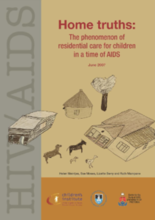In the face of the burgeoning AIDS epidemic in sub-Saharan Africa, there is widespread concern that responses to increasing numbers of orphans are resulting in a proliferation of orphanages across the region. This unease emanates from the view that care for children –orphaned or otherwise – in a ‘home’ and ‘community’ environment is ideal. Institutions, on the other hand, are noted to impact negatively on children, to operate as ‘magnets’ for children growing up in poverty-stricken environments, and to be disproportionately costly. Arguing that residential care violates the principles of the UN Convention on the Rights of the Child, the international child welfare sector is united in advocating its use as only a temporary ‘last resort’ for children. The position is shared by the South African government and other key players in the local child welfare sector.
In practice, all too often government’s interactions with residential care settings are fraught with confusion and frustration. Mixed messages are communicated to unregistered homes: Contradictory funding mechanisms operate within and between departments and tiers of government. Social workers place children in care at unregistered homes while concomitantly homes’ official registration is rejected. The drive to place children in family-based settings is not matched by the capacity of the Social Services to process, monitor or support placements adequately. Services aimed at ‘prevention’ and ‘early intervention’ – critical components of the Department of Social Development’s vision for the provision of a developmental continuum of care for children – remain insufficiently resourced, and limited in reach. Homes are refused registration and are shut down on the grounds that residential care is unsuitable for children, while current circumstances render overburdened and under-funded state Social Services unable to support children in families adequately. Paradoxically, at the core of the Developmental Social Welfare mode l that underpins all post-1994 social development policy in South Africa is a recognition of the value inherent in ‘indigenous’ responses. The model sets out to resource and empower local level insights and responses to social circumstances and to place emphasis on the provision of a wide range of interventions that together support a broad ‘continuum of care’ for children as part of wider social development goals. It is precisely the creativity and sensitivity of local responses that the model aims to build upon in strengthening social service delivery.
However, it is also the complexity and the ambiguity that is described in the course of this report that makes the broad arena of residential care for children a difficult one for the State to systematize, support, monitor and regulate. The danger is that at this time of much policy and legislative review in South Africa we – as both government and the children’s sector – promote unhelpful, inappropriate, unfacilitative policy and legislation based on conventional and simplistic notions of what residential care is and should be. It would be preferable to seize the opportunity to ensure flexibility in our policy and law that recognizes the need to resource as well as regulate the wide variety of informal social care responses that exist.
©Children's Institute, University of Cape Town, University of Pretoria

